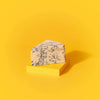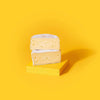Stilton: Everything you need to know about this blue cheese
By Edward Hancock
Oct 21, 2021

What is Stilton?
If you asked anyone to name a British Cheese, there are probably 2 names that would account for 95% of the answers. Cheddar, and Stilton. With no legal naming protections (known as Protected Designation of Origin, PDO) though, cheddar has somewhat lost its identity, and can be associated with anything from a slice of mellow American burger cheese all the way to a clothbound raw milk Somerset hard cheese. In fact, you could start making a cheese tomorrow, and call it cheddar!
Stilton however has been well defined, and protected, and as a result, when we see a Stilton, we all know exactly what we’re going to get.
Where is Stilton cheese produced?
There are only 6 Stilton makers in the world, mainly due to the fact Stilton has to be made in either Nottinghamshire, Derbyshire or Leicestershire, and it has to be made with full fat milk from those counties as far as demand allows (so in practice, not at Christmas!). There are also a number of requirements in terms of the cheesemaking process, including not pressing the cheese, and making the cheeses in a cylindrical shape. The six producers able to call their cheese Stilton are:
- Colston Bassett
- Cropwell Bishop
- Long Clawson
- Tuxford & Tebbut
- Hartington Dairy
- Websters
The history of Stilton:
The history of Stilton is a long one, with a first literary reference to the cheese in 1727. Sold at The Bell Inn in Stilton, which was a coaching stop on the main road from York (and the North) to London, word spread amongst the well-heeled London folk of this wonderful regional blue cheese, and Stilton became a prized asset.
Incidentally this was around the time of the Second Hundred Years War with France, when the French stopped exporting wine to the UK, and as a result the Brits had to go further afield (to Portugal of all places!!) for their wine. In order to adapt the wines to the British consumer (sweeter and more aromatic preference) brandy was added. So in London, high society would be seen eating Stilton and drinking Port, hence it became highly aspirational, and is why we still continue to traditionally pair Stilton and Port.
Into the 20th Century, Stilton continued to be made on farms in the qualifying counties, and would have been made with raw milk. However, in the 1980’s this changed. With ever growing demand for Stilton, both in the UK and internationally, the Stilton Producers Association decided that given milk was being brought in from more farms, and further afield, and that the cheese was also travelling further and to regions where perceptions of raw milk were fairly negative, the cheese should be pasteurised. In 1989, Colston Bassett creamery made the last batch of raw milk Stilton. For 16 years, there was no Stilton-style cheese made in the qualifying counties with raw milk. That was until Joe Schneider and Randolph Hodgson decided to fill the gap, developing Stichelton in 2006, made at The Welbeck Estate in Nottinghamshire (not strictly a Stilton). Since then, a second Stilton-style raw milk cheese has been developed in Leicestershire, namely Sparkenhoe Blue, made by Will Clarke, son of the makers of Sparkenhoe Red Leicester (incidentally the last remaining raw milk farmhouse Red Leicester made in the world!).
Of course, as mentioned earlier, Stilton is protected by a PDO, and part of that PDO stipulates it must now be made with pasteurised milk. Therefore, Stichelton and Sparkenhoe Blue are restricted from being called Stilton. A real shame considering they are cheeses that truly represent the great history of this incredible cheese (raw farmhouse milk all year round).
So, what is the relevance of the use of raw milk (or the lack of it). Well originally, and still contained within the PDO of Stilton production, the quality of Stilton was attributed as follows:
‘The East Midlands offer particular geographical conditions which give Stilton cheese its distinctive taste…the counties provide a very rich soil most appropriate for dairy farming….Consequently because the cows feed on grass growing on rich soil, they produce rich high quality milk, necessary for making Stilton cheese.’
The land, the soil and the climate play a huge part in making Stilton what it is, and the best way to represent that is by leaving the milk that the cows produce raw (ie not heat treating it to kill the natural bacteria and microflora in the milk which also kills its unique flavour) but also using milk exclusively from those named counties. So in truth, particularly at Christmas, the truest expression of the traditions of Stilton, and its history, could be argued to be Stichelton and Sparkenhoe Blue.
When did Stilton Become Synonymous with Christmas?
Well that comes down to seasonality. Cheese is just as seasonal as fruit and vegetables, and cows tend to produce their richest milk in September, whilst grazing on grass, and what is called the ‘second growth’ grass. Stilton is matured for 10-12 weeks, so milking in September, and then maturing to perfection gets you right to Christmas!


